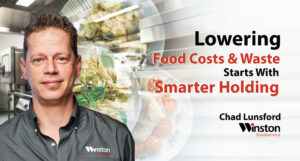As anyone who uses CVap® equipment can tell you, it’s an amazing technology. Whether holding or cooking, CVap equipment offers users precision that’s simply unrivaled by other brands. The oven design and the science behind it are simple. As is often the case with new equipment, there can be a learning curve. But once you wrap your head around CVap’s oven settings (or setpoints), you can achieve amazing results.
Winston Foodservice’s CVap Oven Technology

Unlike a conventional oven or hot holding cabinet, where you simply set one temperature, CVap technology is based on a dual heat system, comprised of both a vapor heat system and an air heat system. Vapor heat dictates the desired food temperature. Air heat controls the rate of moisture evaporation from the food’s surface.
It’s not as complicated as it sounds. Check out this chart, which delves into where particular holding and cooking processes fall on the setpoints scale.
What are Oven Settings, or “Setpoints”?
Settings, or setpoints tell the oven (or holding cabinet) what to do. As you can see in the setpoints chart, CVap ovens are capable of a wide range of settings. For example, steaming in CVap requires lots of vapor heat, but little air heat. On the other end of the spectrum, baking requires moderate vapor heat, but much more air heat (as much as 200°F above the vapor temperature).
Every food has recommended setpoints. In case you’re curious, click the following links to see the recommended setpoints for our CVap Retherm Ovens, Cook and Hold Ovens, Holding Cabinets, and Hold & Serve Drawers.
Are the Oven Settings for all Humidified Ovens the Same?
The short answer is no. Although CVap ovens do incorporate interior water baths (or evaporators), they function much differently than other humidified ovens.
Most manufacturers who tout “humidity control” do so by using heated air as their primary heat source. Because air heat alone will inevitably draw moisture out of the food, these manufacturers introduce water vapor into the cooking chamber. Although these ovens can be set to specific relative humidity (RH) levels, RH only has an indirect effect on food temperature. RH ovens are an improvement over convection and conventional ovens, but they aren’t as good as they could be.
CVap ovens, on the other hand, operate exactly the opposite. Thermodynamics dictates that the temperature of moisture within food will naturally reach equilibrium with the temperature of water or heated water vapor that surrounds it. This is the basic principle that makes sous vide so accurate. Because CVap technology precisely controls the temperature of the water vapor, it also directly controls the temperature of the food. CVap utilizes air heat to control the evaporation of surface moisture from the food. Moist foods need little air heat. Crisp foods need more air heat. The combined heat systems provide a temperature and texture precision that is simply unrivaled.
Should You Always Follow the Recommended Oven Settings?
To get the best results, we suggest following the recommended oven settings. Winston has conducted years of testing to determine the ideal settings for optimal results.
But of course, end users are free to operate their equipment however they’d like. And “happy accidents” do happen sometimes when experimenting with new settings.
Occasionally our customers have asked us to develop oven settings for their specific menus. It’s a service we’re happy to provide. Our corporate chef reviews the questions and expectations of the customer, conducts, and documents menu testing, and delivers her recommendations to the customer.
Below are some examples of common items that are requested often.

Fried Chicken – Holding
- Breaded – Vapor Temp 130-140°F / Air Temp 165-175°F
(Because fried chicken involves a bigger differential (the difference between the vapor and air setpoints), it has a shorter holding time before food quality starts to decrease.)Hold Time: 2 hours (+/- Depending on user’s own quality expectations.)
Hold Vapor: 130-140°F
Hold Air: 170-190°F (Keep at least +40-50°F differential or increase air temp for crispier skin.)

Whole Roasts – Prime Rib
- Cook Time: 6 hours
(Additional time may be needed if cooking more than three whole roasts.)
Cook Vapor: 130-135°F for medium rare
Cook Air: 180-185°F (Keep a +50°F differential.)

Roasted Chicken – Holding
- Hold Time: 2 hours
(+/- Depending on user’s own quality expectations.)
Hold Vapor: 140-150°F
Hold Air: 160-180°F (Keep at least +20°F differential or increase air temp for crispier skin.)
Of course, many other foods are perfect for cooking or holding in CVap equipment. If you don’t see a particular item in the guidelines, just reach out to the Customer Care team. We’ll get the answer for you!





